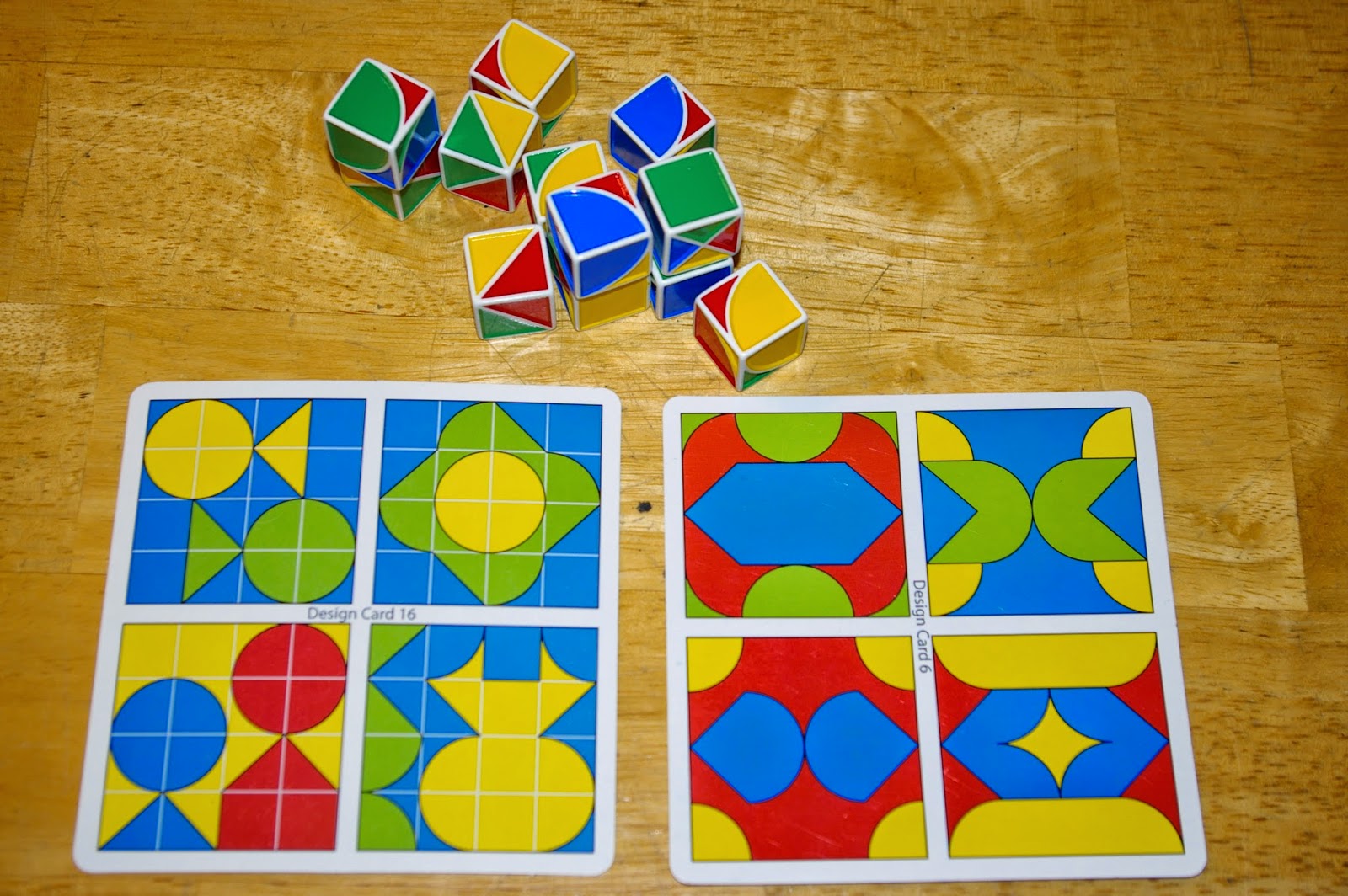 |
| Pixy Cubes - 124 colorful patterns |
Pixy Cubes offers a lot of fun in the therapy setting and kids have responded well to it. These cubes are solid and brightly colored (blue, green, red, yellow) and each side of a cube has a different design or color combination. The colors are part of the cube, not a sticker that will fall off. Designs on the cubes include 2-color 1/4 circle, solid color, 2-color diagonals, and 4-color triangles. I love almost any game with small dice sized cubes so that I can include cupping the hand and in-hand manipulation, and this one does not disappoint.
 |
| 4 patterns per side. On the left, there is a grid printed over the squares. On the right there is no grid. |
This game includes
4-cube designs printed on a grid, 16-cube designs printed on a grid, and 16-cube designs not printed on a grid. You can grade the activity by using the cards in that order. By the time you get to the 16 cube side with no grid, you will have to be able to mentally separate the squares.
All
cards are printed front and back. The
small cards have 1 pattern on each side and the large cards have 4 patterns on
each side. This is a total of 20 patterns on the small cards and 104 patterns
on the large cards. The large cards are too small to build on top of, although I did go to Staples and enlarge the cards on their color copier so that they are the correct size to build on for those who have trouble building in a free space. I like this game for spatial
orientation as 12 of the cubes will always have to be placed in specific
directions (the other four are solid colors).
The box is metal and the lid does not stay on very tightly and so I just put a rubber band around mine.
Try this:
- Separate out and sort the cubes to the correct sides for the individual if you want to decrease the difficulty or concentrate on another aspect, such as spatially orienting the cubes or hand skills.
- Ask the individual to turn one cube at a time, in his fingers and using only one hand, to find the correct side of each cube for placement.
- Study a 4 cube design, then turn it over and build it from memory.
- Ask the individual to cup the hands and shake the cubes before starting. If he has trouble cupping the hand, place a small ball in the palm and ask him to curl the fingers. Ask him to hold that position as you remove and ball. Add the cubes and ask him to shake and throw. Use all the cubes that apply to the design, then pick up the remainder and shake again. Continue these steps until the image is complete.
- Cover all but the line you are working on if using the card without a grid and the individual is having trouble "seeing" each cube. If the individual gets stuck, I will even cover the whole design except the one cube.
- Place the cubes for a design on the table so that the wrong side is up, requiring the individual to pick up and rotate each cube in-hand, in the fingertips to place.
- Place a cube in the individual's palm. Ask him to bring it to the fingertips and rotate for placement using only that hand.
- Start by placing the cubes directly on top of the 4-cube cards and then move to creating the design next to the card.
- Ask the individual to cup the hand and place one cube at a time in the hand. How many can he hold? Try the other hand, try to hold one more.
- Place several cubes in the individual's non-dominant hand while putting the game away. Have him hold his hand in this cupped position as he removes the cubes one at a time to place in the box. Next switch hands.
- Clean up by picking up one cube at a time and squirreling it in the palm. How many can you hold without dropping any? Try again for one more. Put cubes away in the box by the handfuls.
- Work on in-hand manipulation, manual dexterity, distal finger control, palmar arch development, in-hand manipulation, fine motor precision, visual discrimination, visual memory, figure ground, spatial relations, visual closure, visual form constancy, visual scanning, sequencing, process skills, executive functioning skills, play and leisure exploration and participation
If you would like to purchase this game or just want more information, click on the image below.





